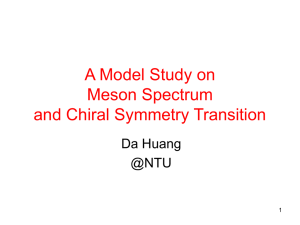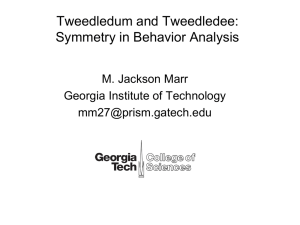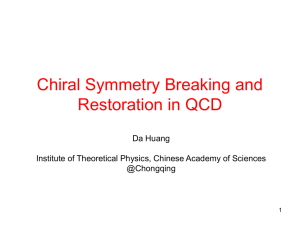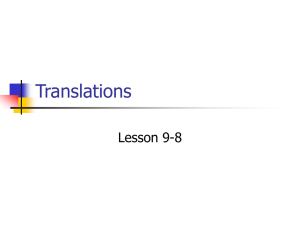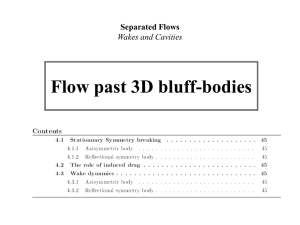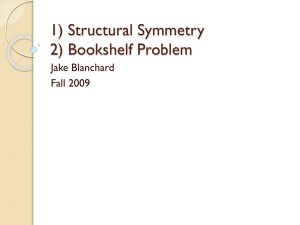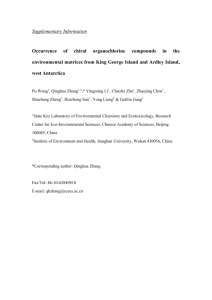Meson in matter
advertisement
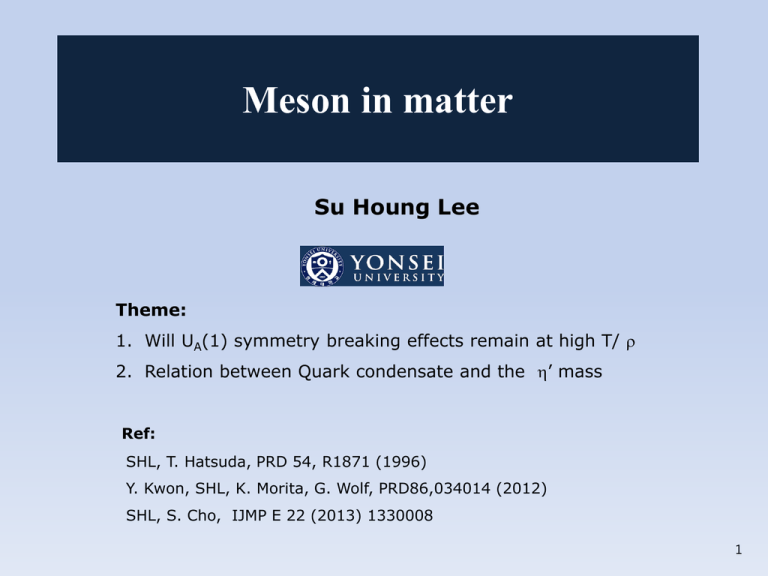
Meson in matter Su Houng Lee Theme: 1. Will UA(1) symmetry breaking effects remain at high T/ r 2. Relation between Quark condensate and the h’ mass Ref: SHL, T. Hatsuda, PRD 54, R1871 (1996) Y. Kwon, SHL, K. Morita, G. Wolf, PRD86,034014 (2012) SHL, S. Cho, IJMP E 22 (2013) 1330008 1 h‘ mass , Chiral symmetry restoration and UA(1) effect ? QCD Lagrangian Chiral sym restored Usual vacuum U N F U N F SU N F SU N F U 1 SUN F U 1 uL,R uL,R U d L,R d L,R mass s ~ q q N f GG 4 5 qq 0 a1 ? h‘ r ? 2 Experimental evidence of property change of h‘ in matter ? CBELSA/TAPS coll h ' 0 0h 6 V 37 10 10 MeV i10 2.5 MeV Nanova et al. 1. Imaginary part: Transparency ratio 2. Real part: Excitation function + momentum distribution of the meson 3 Correlators and symmetry 1. Chiral symmetry breaking in Correlator 0 q 0 q0 or VV AA m 0 0 form factor Cohen 96 2. UA(1) breaking effects in Correlators h 'h ' 0 m 0 0 form factor m N f 2 zero mode Hatsuda, Lee 96 4 Quark condensate – Chiral order parameter Finite temperature Lattice gauge theory qq T / qq T 0 ss T / qq T 0 0.8 cc 1 2 G 12mc Finite density 1 ss T ms exp ms / T T/Tc Linear density approximation qq r r/rn 5 Chiral symmetry breaking (m0) : order parameter • Quark condensate q 0q0 lim T rS ( x,0) dAe SQCD x 0 dAe Casher Banks formula: S QCD 1 T r 0 0 / m D 1 Tr S 0,0 i 5 S 0,0i 5 2 iD / using q 0q0 T r 0 0 m m2 2 where 0 0 | 0 m 0 0 0 0 Chiral symmetry breaking order parameter qq TrS 0, x 1 S 0, x i 5 S 0, x i 5 2 0 0 6 • Other order parameters: correlator 1 4 d x V q x qx , q 0q0 q x a i 5 qx , q 0 a i 5 q0 T r S ( x,0) S (0, x) 1 T r ai 5 S ( x,0) ai 5 S (0, x) 1 1 5 a 5 a TrS ( x, x) TrS (0,0) 1 Tr S ( x,0) S 0, x i 5 S 0, xi 5 ONc TrS ( x, x) TrS (0,0) O1 7 • Other order parameters: V - A correlator (mass difference) 1 4 d x V q x a qx , q 0 a q0 T r a S ( x,0) a S (0, x) a 5 a 5 a T r S ( x,0) S 0, x i 5 S 0, xi 5 qq a Tr ai 5 S ( x,0) ai 5 S (0, x) Tr a S ( x, x) Tr a S (0,0) a a q x a i 5 q x , q 0 a i 5 q0 TrS 0, x S 0, x i 5 S 0, x i 5 0 0 8 • Meson with one heavy quark : S-P 1 d 4x V H x i 5 q x , q 0i 5 H 0 T r SH ( x,0) S 0, x i 5 S 0, xi 5 • H x qx , q 0H 0 Baryon sector : L – L* 1 4 d x V u i Cd H x, u i Cd H 0 T 5 5 T u Cd H x , u Cd H 0 T SH x,0T r S ( x,0) S x,0 i 5 S x,0i 5 T 9 Correlators and symmetry 1. Chiral symmetry breaking in Correlator 0 q 0 q0 or VV AA m 0 0 form factor Cohen 96 2. UA(1) breaking effects in Correlators h 'h ' 0 m 0 0 form factor m N f 2 zero mode Hatsuda, Lee 96 10 UA(1) effect : effective order parameter (Lee, Hatsuda 96) • Topologically nontrivial contributions Z Zn 0 Zn 1 ..... • h ‘ correlator : n = 0 part 1 d 4 xe ikx q x i 5 qx , q 0i 5 q0 q x a i 5 qx , q 0 a i 5 q0 V n 0 : T r i 5 S ( x,0)i 5 S (0, x) T r i S ( x,0) i S (0, x) a 5 a 5 Tr i 5 S ( x, x) Tr i 5 S (0,0) i 5 ~ GG Tr i 5 S ( x, x) Tr i 5 S (0,0) i 5 r 0 2 T. Cohen (96) 11 • h ‘ correlator : n nonzero part Lee, Hatsuda (96) 1 d 4 xe ikx q x i 5 qx , q 0i 5 q0 q x a i 5 qx , q 0 a i 5 q0 V For SU(3) : 1 d 4 x u0 x d 0 0 d 0 0u0 x d 4 ys0 y ms s0 y permutatio ns V uL dL n=1 n 0 uR dR sL const x mq q q sR q 3 For SU(2) : Always non zero 1 d 4 x u0 x d 0 0 d 0 0u0 x V n 0 const uL dL n=1 uR dR For N-point function: U(1)A will be restored with chiral symmetry for N > NF but always broken for N < NF 12 • Recent Lattice results ? 1. S. Aoki et al. (PRD 86 11451) : no UA(1) effect above Tc 2. M. Buchoff et al. (PRD89 054514): UA(1) effect survives Tc in SU(2) in susceptibilities , a , a chiral , h,h UA(1) Chiral symmetry restoration UA(1) symmetry restoration ? But what happens to the h‘ mass? What is the relation to chrial symmetry 13 Correlators and h’ meson mass 1. Witten – Veneziano formula 2. At finite temperature and density 14 h’ mass? Witten-Veneziano formula - I ~ ~ Pk i dxeikx GGx , GG0 • Correlation function • Contributions from glue only • When massless quarks are added • P0 k 0 0 Pk Large Nc argument from low energy theorem 0 Pk i dxeikx j5 x , j5 0 k k n Pn k 0 2 ~ 0 | GG | glueball k 2 mn2 glueballs ~ GG mesons ~ GG • Need h‘ meson 2 ~ GG Nc 1 with mh2' O N c k 2 mh2' P(k 0) P0 0 k 2 mn2 ~ GG N c2 ~ 0 | GG | h ' 2 ~ 0 | GG | m eson ~ 0 | GG | h ' mh2' 2 0 15 Witten-Veneziano formula – II • ~ 0 | GG | h ' h‘ meson 2 mh ' 2 P0 0 2 4 1 N F mh2' fh ' 2 8 2 NF 4 G 2 mh ' 3 11N / 3 2 Lee, Zahed (01) mh2' fh ' 2 8 2 G 11N Should be related to 250 MeV mh ' 432 MeV at m 0 limit mh ' (958) mh (547) 411MeV 16 Few Formula in Large Nc • Meson m1, 1/Nc , gmmm 1/ Nc1/ 2 , 0 | qq | m Nc1/ 2 , 0 | GG | m Nc1/ 2 • Glueball m1, 1/Nc2 , g ggg 1/ Nc , 0 | qq | m Nc , 0 | GG | g Nc • Baryon mNc , gmBB Nc1/ 2 , B | qq | B Nc , B | GG | B Nc 17 Witten-Veneziano formula – III Nc counting and glueball • h‘ meson ONc1 O1 / Nc1 ~ 0 | GG | h ' 2 mh2' 8 2 4 P0 0 G 3 11N / 3 2 ONc2 h ‘ mass is a large 1/Nc correction • glueball ONc2 0 | GG | g O1 mg2 2 2 4 18 S 0 0 G 3 11N / 3 2 ONc2 18 Witten-Veneziano formula – IV • Low energy theorem is a Non-perturbative effect S q i dxeiqx 3 2 3 2 18 2 G x G 0 G 4 4 11 Pq i dxeiqx 3 ~ 3 ~ 8 2 GG x GG 0 G 4 4 11 h ‘ mass is a large 1/Nc correction 19 Witten-Veneziano formula at finite T • ~ ~ Pk i dxeikx GGx , GG0 Large Nc counting N c2 • N c2 (Kwon, Morita, Wolf, Lee: PRD 12 ) m Nc At finite temperature, only gluonic effect is important Pk 2 ~ 0 | GG | glueball k m 2 glueballs 2 n mesons Glue Nc2 P(k 0) P0 0 2 ~ 0 | GG | m eson k m 2 Quark Nc ~ 0 | GG | h ' 2 mh ' 2 n ScatteringT erm Quark Nc2 ? 2 c scattering? 20 • Large Nc argument for Nucleon Scattering Term ONc ~ GG ONc ~ GG Nucleon Witten Nucleon ~ GG 2 1 N c 1/ 2 N c N c Nc That is, scattering terms are of order Nc and can be safely neglected ~ n | GG | n mN 2 r density 1 N c2 Nc N c 21 • Large Nc argument for Meson Scattering Term O1 ~ GG O1 ~ GG Meson Witten ~ GG 1 N c2 1/ 2 Nc 2 2 1 1/ 2 1 Nc That is, scattering terms are of order 1 and can be safely neglected P0 0 ~ 0 | GG | h ' 2 2 WV relation remains the same mh ' 22 • LET (Novikov, Shifman, Vainshtein, Zhakarov) at finite temperature : Ellis, Kapusta, Tang (98) d ikx 2 Op i dx e Op x , g GG0 0 2 d 1 / 4 g0 d Op d Op 2 d 1 / 4 g0 • Lee, Zahed (2001) T T 8 2 constM 0 exp 2 c' T d Op bg0 32 2 d T Op b T T d c ' T T0 32 2 d T Op b T T0 2 2 P0 0 d T G b T Moritaet al. (2012) WeakT dependenceeven near Tc P0 0 ~ 0 | GG | h ' 2 c 2 mh ' 23 • ~ 0 | GG | h ' at finite temperature ~ ~ Pk d 4 xeikx GGx , GG0 4 k k n d 4 xeikx N F 2 ~ 0 | GG | h ' k 2 mh2' 2 ... q xi qx, q 0i q0 q xi 5 n 5 qx , q 0i n q0 sym restored phase chiral 4 k k n d 4 xeikx N F 2 q xi 5 a qx , q 0i n 5 a q0 q x i a qx , q 0i n a q0 0 for any k , when Chiral symmetryis restored Therefore, ~ 0 | GG | h ' 0 when chiral symmetry gets restored 24 • W-V formula at finite temperature: qq 2 ~ 0 | GG | h ' mh2' 2 P0 0 2 4 2 d T G 3 11 T 2 Smooth temperature dependence even near Tc Therefore , mh ' mh q q eta’ mass should decrease at finite temperature 25 Experimental evidence of property change of h‘ in matter ? CBELSA/TAPS coll h ' 0 0h 6 V 37 10 10 MeV i10 2.5 MeV 10 % reduction of mass from around 400 MeV from chiral symmetry breaking 26 Summary 1. 2. h’ correlation functions should exhibit symmetry breaking from N-point function in SU(N) flavor even when chiral symmetry is restored. For SU(2), UA(1) effect will be broken in the two point function In W-V formula h’ mass is related to quark condensate and thus should reduce at finite temperature independent of flavor due to chiral symmetry restoration a) Could serve as signature of chiral symmetry restoration b) Dilepton in Heavy Ion collision c) Measurements from nuclear targets seems to support it ? 27 Summary 1. Chiral symmetry breaking in Correlator 0 q 0 q0 or VV AA m 0 0 form factor 2. UA(1) breaking effects in Correlators h 'h ' 0 m 0 0 form factor m N f 2 zero mode Restored in SU(3) and real world 3. WV formula suggest mass of h ‘ reduces in medium and at finite temperature: due to chiral symmetry restoration 4. Renewed interest in Theory and Experiments both for nuclear matter and at may be at finite T 28


